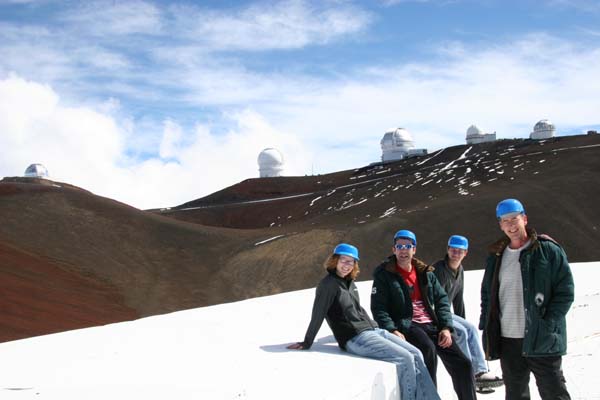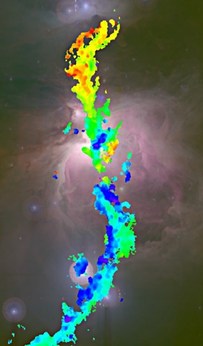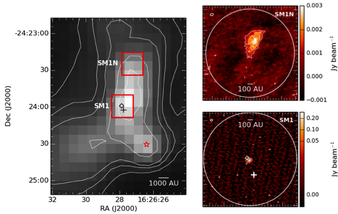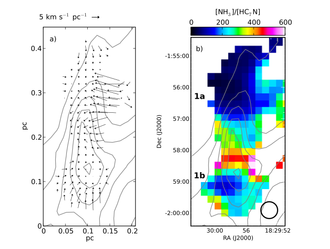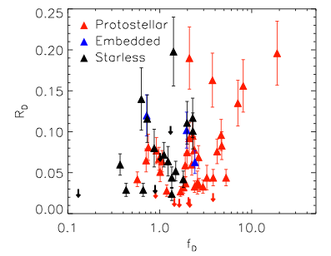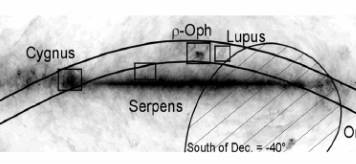General research interestsI study the earliest phases of star formation through observations of light emitted by dust and molecules in the very cold, very dense environments in which stars are born. Many molecular emission lines are found at radio wavelengths, so I often observe star forming regions with large radio telescopes like the Green Bank Telescope and telescope arrays like the Atacama Large Millimeter Array (ALMA) in Chile and the Very Large Array in New Mexico.
Some of my recent and ongoing projects are described below. |
The green bank ammonia survey (GAS)I am leading the Green Bank Ammonia survey (GAS, co-PI with Jaime Pineda), a Large Program mapping emission from the dense-gas tracer NH3 (and other species) over all star forming clouds within 500 pc of the Sun. These observations are providing the key velocity information needed to test theoretical models of star formation in dense molecular filaments.
Published papers: Redaelli + the GAS team. 2017, ApJ Keown + the GAS team. 2017, ApJ Kirk + the GAS team. 2017, ApJ Friesen & Pineda + the GAS team. 2017, ApJS All data and data products will be publicly released. The first data release is at the Dataverse. Data reduction, imaging, and analysis pipelines are on github. |
|
The motions of dense molecular gas (foreground) traced by GAS in NH3 seen in contrast to the optical view of the Orion molecular cloud (background).”
Credit: Stephen Gwyn, Canadian Astronomy Data Centre/National Research Council of Canada (CNW Group/National Research Council Canada) |
Structure and stability of dense gas in clustersFriesen, Bourke, Di Francesco, Gutermuth & Myers. 2016, ApJ
Friesen, Di Francesco, Myers, Belloche, Shirley, Bourke & André. 2010, ApJ Friesen, Di Francesco, Shimajiri & Takakuwa. 2010, ApJ Friesen, Di Francesco, Shirley & Myers. 2009, ApJ In these papers, we study the hierarchical fragmentation, gravitational stability and chemical evolution of dense molecular gas forming young stellar clusters in nearby star-forming regions. In Serpens South, for example, we show that filaments of dense gas are extremely quiescent, and the complex as a whole is unstable to collapse in the absence of strong magnetic field support. We use a combination of interferometer and single-dish observations to map the continuum emission from cold dust and line emission from dense gas-tracing molecules to probe the physical evolution of star-forming material. |
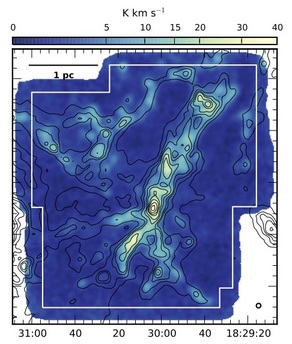
Integrated NH3 (1,1) intensity observed toward the nearby Serpens South protocluster with the 100 m Green Bank Telescope at 32′′ resolution. Contours show dust continuum emission from cold dust at 500 micron observed with the Herschel Space Observatory. The NH3 data enable the direct calculation of gas temperature and analysis of the kinematics, and reveal the overall gravitational instability of the complex.
|
Probing Circumstellar Accretion regions with ALMAFriesen, Di Francesco, Bourke, Caselli, Jørgensen, Pineda & Wong. 2014, ApJ
In ALMA's Cycle 0, we targeted two evolved yet still (presumably) starless cores within the Ophiuchus star forming region to understand the evolution of a core's density profile and trace the gas kinematics just prior to forming a protostar. The exciting discoveries - one core contains an extremely young protostar and early protostellar disk only 40 AU in size, while the second core may be the first detection of a pseudodisk or circumstellar accretion region around a first hydrostatic core - reveal previously hidden structures within star-forming cores and highlight ALMA's amazing capabilities. Stay tuned for ALMA Cycle 2 and Cycle 5 data! |
Tracing infall in star forming regionsCampbell, Friesen, Martin, Caselli, Kauffmann & Pineda. 2016, ApJ
Friesen, Medeiros, Schnee, Bourke, Di Francesco, Gutermuth & Myers. 2013, MNRAS Schnee, Brunetti, Di Francesco, Caselli, Friesen, Johnstone & Pon. 2013, ApJ In these studies, we are looking at the infall of molecular gas in star forming regions. In Friesen et al., we present evidence for substantial accretion onto star-forming filaments from the surrounding, less dense gas in the Serpens South protocluster through analysis of long carbon-chain molecular emission. In Schnee et al., we correlate the infall velocity with the mass of collapsing, star-forming cores, and show that highly deuterated starless cores are more likely to show infall motions indicative of gravitational collapse. |
Deuterium fractionation in cold cloudsFriesen, Kirk & Shirley. 2013, ApJ
At the low temperatures and large densities of star-forming regions, we find significant chemical differentiation in the molecular species present in the gas phase. In particular, the deuterium fractionation of many species - where a deuterium atom replaces a hydrogen atom - increases. In Friesen et al., we measure the deuterium fractionation toward a large number of star-forming cores in the Perseus molecular cloud and show it does not exhibit simple correlations with other tracers of advanced core evolution. In Campbell et al., we survey the Perseus cores in optically thick and optically thin emission lines at the JCMT to identify which show evidence for infall (collapse) motions. We find surprisingly large infall speeds toward some targets, inconsistent with typical core collapse models. |
The JCMT Gould Belt Legacy SurveySadavoy et al. 2013, ApJ
Buckle et al. 2012, MNRAS Most star formation within 0.5 kiloparsecs lies in Gould's Belt, a ring around the sky containing star-forming molecular clouds centred on a point 200 parsecs from the Sun and tilted at 20 degrees to the Galactic Plane. The aim of the James Clerk Maxwell Telescope Gould Belt Legacy Survey is to map the submillimetre continuum emission and CO line emission from multiple clouds within the Gould Belt, including Ophiuchus, Serpens, and Orion. |
